The Building Safety Act 2022
An Introduction to the Building Safety Act
The Building Safety Bill recieved Royal Assent on 28 April 2022 to create the Building Safety Act
The Building Safety Act centres on who and how the building process will be regulated and who is accountable for what. It is, for the most part, a huge improvement to the regulatory landscape and will, without question drive a healthier culture centred on improvements in the exchange of information, better design and specification, considered procurement and ensure key details are decided before we are stood on site, scratching heads.
An area of concern is, however, the accompanying changes to the Defective Premises Act 1972, Section 38 of the Building Act 1984 and the implementation of a new Construction Products Cause of Action and Building Liability Order designed to support claims on existing buildings going back in some cases up to 30 years. The Act is very light on efficient mechamisms to fairly manage disputes.
Register for the new FIS Building Safety Act Training Course
FIS has developed an online training course to support members in understanding compliance with the Building Safety Act. The course has been designed to be user-friendly guiding members through the process of compliance as it relates to working in the finishes and interiors sector.
Sector Guide – Competency Management Plans
FIS Guide – An Introduction to the Building Safety Act
White Paper – Introduction to the golden thead and digital information plans
Non-members can request a copy by contacting us here
Latest news related to the Building Safety Act
Building Safety Act: Sector Prioritised in Competence Drive
Following the Grenfell Tower...
Working together to transform construction
Build UK is working on...
Safety case: what you’ll need to know and do
The Building Safety Act...
BuildUK's Guide to the New Building Safety Regime
With many of the new requirements coming into force this year, FIS members have access to a newly published comprehensive overview of the regime, compiled by Build UK. This guidance will ensure all members are aware of their responsibilities.
The Building Safety Act– Headline Changes
The aim of the Act is to:
- Ensure there are clearly identified people responsible for safety during the design, build and occupation of a high-rise residential building.
- Establish a Building Safety Regulator to hold to account those who break the rules and are not properly managing building safety risks, including taking enforcement action where needed.
- Give residents in these buildings more routes to raise concerns about safety, and mechanisms to ensure their concerns will be heard and taken seriously.
- Extend rights to compensation for substandard workmanship and unacceptable defects.
- Drive the culture change needed across the industry to enable the design and construction of high-quality, safe homes in the years to come.
Primarly the Act is focussed on improving safety in the construction of High Risk Residential Buildings (>18m), but it will have wider implications and much of the secondary regulation and cultural changes impact on the wider sector.
Introducing a new Regulator
Most significantly the Act provides powers to a new Building Safety Regulator who will oversee the construction process and is now empowered to start holding individuals to account and taking enforcement action when required. It also defines the role of the Construction Products Regulator in providing oversight for testing and control of the supply of construction products – the Construction Products Regulator will have the power to remove product from the market.
The Building Safety Regulator will also oversee the work of the Building Competence Committee to advise it on industry competence, to monitor and facilitate improvement of industry competence and provide guidance. This work will be particularly focussed on the key actors defined in the Act (aligned to the CDM regulations), the Client, Principal designer, Principal contractor, Designer and Contractor.
A Building Advisory Committee is also being set up to advise the Building Safety Regulator on issues other than competence. This replaces the existing Building Regulations Advisory Committee (BRAC).
A Residents’ panel will also be established to ensure the Building Safety Regulator is grounded and in touch with the residents of the high risk buildings.
A Gateway approach
The Act will see the implementation of specific gateway points at design, construction and completion phases to ensure that safety is considered at each and every stage of a building’s construction, and safety risks are considered at the earliest stage of the planning process.
- Gateway 1: The planning application stage; tighter controls around the fire statement, competency of those preparing and scrutinising.
- Gateway 2: the initial building control stage before works commence.
- Gateway 3: the completion / final certificate phase pre-occupation.
Gateway 2 s of particular significance to the finishes and interiors sector, this gateway provides a “hard stop” where construction cannot begin until the Building Safety Regulator is satisfied that the duty holder’s design meets safety requirements.
Duty Holders
Building Regulations now align ‘health and safety’ and ‘building safety’ requirements should align though the Construction (Design and Management) Regulations 2017 (CDM) for ALL buildings and ALL building work.
The CDM Regulations are built around the concept of statutory duty holders. This starts with the client who must allow time and resource to support compliance and appoint compenent individuals and organisations to act as Principal Designer and Principal Contractor.
The role of the principal designer is pivotal, both in terms of creating the right environment and supporting information management (including design change controls that make sure design intent is not undermined through procurement or installation). Designers, principal contractors and contractors all have regulated duty holder responsibilities
FIS Formal Position Statement on the Building Safety Act
“The Building Safety Act is to be welcomed and the emphasis on future works and how the process of construction should evolve is pretty much what we have been calling for years. However mechanisms to manage legacy issues must evolve quickly and vitally with the support of Government. This is essential to avoiding the inevitable avalanche of blame that businesses (including many SMEs) will face.
Whilst Polluter Pays is a simple political statement it is a much more complex moral and legal argument. Of course, we have to be accountable for our past deeds and leaseholders should absolutely be protected in every way. However, amends to the Act focus on blame, but are light on the mechanisms to manage the myriad of contractual disputes that could emerge through the supply chain.
Construction disputes are typically multi-faceted, often complicated by shared responsibility and always worse if there is not a clear paper trail. We need to look to reasons behind and lessons learned from the implementation of the Construction Act to ensure the unintended consequences don’t unravel great progress being made and decimate the sector (creating a shockwave that will impact construction as a whole).
Whilst the Act extends the legacy liability periods for construction, this is not matched with a similar responsibility for those that were part of our risk management equation such as insurers. Looking forwards it recognises the need to change, but when it comes to legacy, it simply doesn’t reflect that, at times, the system itself was failing many of those working in it and that contracts were often signed under duress and do not match the reality on the ground.
We will continue to work with Government and colleagues in the CPA and CLC to try and find a fair and proportionate approach, but it is vital in doing this that we unite the supply chain and create an environment that doesn’t facilitate the creation of a whole new opportunistic “PPI Claims” type industry and favour those that can (or historically could) afford the best lawyers. We must ensure that the blame doesn’t land disproportionately on those never set up to succeed by failings elsewhere and the polluters are genuinely held to account, not those it is easiest and most convenient to blame.”
We will continue our work with the wider construction sector in representing the views of our members on this matter and will be raising these concerns through the Civil Service and relevant Politicians over the coming months.
Ongoing FIS Work
FIS has developed this hub, guides and supporting FIS Building Safety Act Training Modules to help our members navigate this new legislative landscape. We have also reviewed and aligned the FIS PPP Qualifty Framework Toolkit to align to the new landscape and strengthened our Legal Support Services to assist members with some of the contractual issues that have arisen.
FIS Technical Services: FIS is using our Working Groups, our Technical Advisory Service and wider network to identify and work with members to understand where and how compliance and safety can be improved through collective efforts. We ar e extending this work to ensure collaboration is happening across the supply chain through the newly created Passive Fire Knowledge Group (PFKG). The PFKG is a unique non-for-profit collaboration comprising contractors, consultants and relevant trade associations. The focus is encouraging collaboration is to improve the delivery of well designed, specified and installed passive fire protection by focusing on 3 key areas: Process, Testing and Education. The group aims to investigate, understand, inform and promote knowledge and research in all areas of passive fire protection.
FIS Consultation: FIS has been working on a number of fronts looking at how we support the “Responsible No”. As part of this work we have been breaking down the design development process and looking at irreconcilable details. We are looking for member feedback on an outline paper that we have prepared “A Defined Design Development Process”.
FIS Consultation: FIS has estabnlished a new cross-cutting group looking at Walls as a System. A draft paper has been produced by industry experts to examine the standards, the performance requirements then point out where additional time should be invested through early collaboration where the drylining interfaces with Doors, glazed partitioning MEP, other systems such as the structure, and raised access floors. If you would like to see a copy and comment on this draft paper, email joecilia@thefis.org.
Industry Competence: FIS has been active across a number working groups supporting the Construction Leadership Council and Government Response looking at competence through the supply chain. This work has suported the development of new Competency Standards (all documented in the FIS Guide to Competency Management).
A number of competency Frameworks have been published to support the Finishes and Interiors Sector:
- Drylining Installer Competency Framework
- Project Manager Competency Framework
- Passive Fire Protection Installer Competency Framework
Further pathways are currently being developed with FIS Chairing the newly formed Industry Competence Committee (part of the Regulator) looking at Competency Frameworks for all functions in the Interior Super System. This work is being supported by the FIS Skills Board, core FIS Working Groups. and a vast network of engaged individuals from across the sector. Email info@thefis.org for more details.
Professional Indemnity Insurance: FIS is working through a Construction Leadership Council Working Group to understand and look to address concerns over the cost, availability and limitations in insurance cover for all parts of the supply chain, from principal designer and contractor through to consultants and specialist contractors. In the meantime we are working closely with Specialist Insurance Providers to support members with immediate insurance issues.
FIS Responsible No Campaign: The problem is that if we don’t exercise the option of “No”, if we don’t clarify, qualify and draw the line we take responsibility for issues outside of our control, assume responsibility for compliance and sign up to damages and delays that we can’t cover. Find out more about the FIS Responsible No Campaign Here.
Building Safety Act documents
A full copy of the Building Safety Act is available here.
Guide to the New Building Safety Regime – With many of the new requirements coming into force this year, FIS members have access to a newly published comprehensive overview of the regime, compiled by Build UK. This guidance will ensure all members are aware of their responsibilities.
The Government has published a series of factsheets to help dutyholders and the wider industry understand the new requirements.
The Government is now consulting on aspects of secondary regulation that will support the implementation of the Building Safety Act – you can keep abreast of these consultations here.
Guidance on Collaborative Procurement
The DLUHC has published Guidance on Collaborative Procurement for Design and Construction to Support Building Safety, with the aim of helping clients and the industry to implement procurement practices that will deliver safer buildings post Grenfell. The guidance sets out how public and private sector dutyholders can demonstrate they have used collaborative processes at each of the three gateways under the new regulatory framework to create safe, high‐quality buildings. Including examples of collaborative techniques adopted successfully by other industries, the guidance emphasises that “delivering value for money and safe, high‐performing buildings depend(s) on establishing trusted, collaborative partnerships between the client, the contractor, and the rest of the supply chain”.
The guidance was launched at an event featuring Dame Judith Hackitt and a recording of the discussion is available to view online.
Construction Leadership Council Building Safety Webinars
The CLC has collaborated with the Health and Safety Executive in its capacity as the Building Safety Regulator to deliver a series of webinars for the industry:
Building Safety Fundamentals
The Higher-Risk Buildings Regime –Design and Construction
Competence
The Golden Thread of Information in Higher Risk Buildings
The Roles of Construction Products in Building Safety
DEBATE: What does the draft Building Safety Bill mean and how will it impact construction?
Access the recording of our recent live debate where we gave an overview of draft Bill itself, looking at proposed Gateways, how the Golden Thread of information will be managed and regulated and how the new Regulator will operate.



